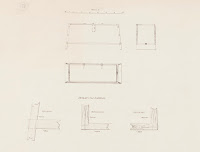Oseberg Chest 178
As you all know, in preparation for our event last month I made a bunch of camp gear. One of those things was my first attempt at a chest!
The original chest, documented as Oseberg 178, was found mostly intact at Oseberg and dates to the 9th century. It is one of a few interestingly similar "sea chest" examples we have of the era. The original was made using mortise and tenon joints, with iron hinges and an iron locking latch.
The plan from the very beginning here was to make a "practice chest" so that I know the angles and sizes I need in order to make a much more authentic chest in the future. As such, I took some liberal shortcuts on this one which allowed me to crank it out in one day and have it ready and complete for the event.
Another member of the group who was also producing camp gear suggested a 5-degree angle for the sides. His cuts looked good to me, so I did the same, making angled cuts on all upward-facing edges on both side pieces.
Rather than using mortise and tenon joints for the floor of the chest, I routed a channel on all four sides and slotted a flat board into it. I tacked and glued it in place, and then countersunk screws into each side to hold it all together. I topped each countersunk screw with tiny cuts of a wooden dowel and glued them in place, then sanded everything flush.
For the lid, I used a leftover piece of hardwood from a previous project and cut it to measure. No fancy hinges or latch on this one-- two small cuts of leather will do for now. Again, this is just the practice piece! I sealed the whole piece in teak oil and let it sit overnight.
Just like that, we have a new home for our pottery and another seat by the fire! Stuffed with thick layered wool and our little linen butt pillows, the pottery has never been safer and everything survived the trip. Although this chest is VERY rough, I'm happy with it for what it is, and I think I have a clear direction for its descendant-- I may even get ambitious, and try the Mastermyr chest!







Comments
Post a Comment